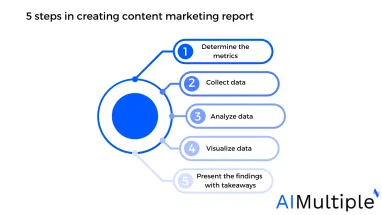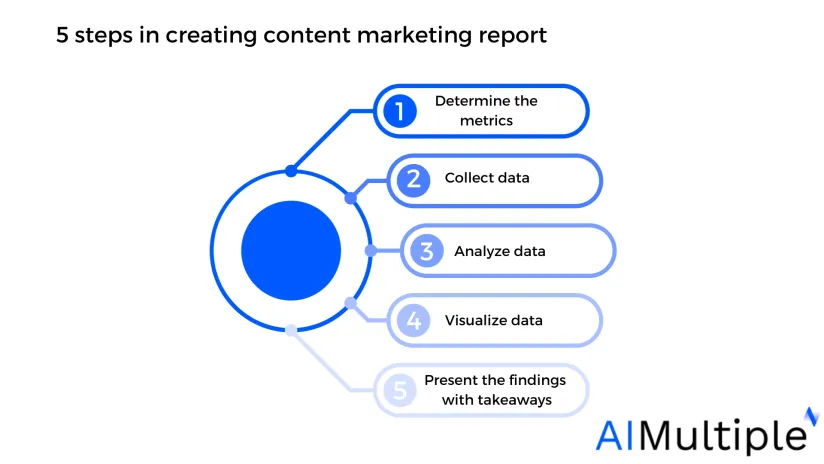Content Marketing Reporting: Benefits, Metrics & Steps in '24


Figure 1. The crucial steps in creating content marketing reporting
More than 70% of B2B companies stated that content marketing becomes more important for their marketing initiatives.1 However, only 40% have a well-documented content marketing strategy.2
Content marketing reporting is crucial to accurately track the performance of content, understand reader engagement, and optimize the content for success. The lack of content marketing reporting may result in low returns from the content marketing campaigns.
This article goes in-depth into content marketing reporting by explaining:
● What content marketing analytics is
● Why reporting content marketing analytics is beneficial
● Top metrics in reporting content marketing analytics
● Steps in content marketing reporting
What is content marketing analytics?
The use of analytics in content marketing is a growing trend, as there is a growing amount of usable data to inform content marketing strategies.
Content marketers report business data analytics in an easily understandable format with metrics stated clearly, graphs explaining the data accurately, etc., so that the decision-makers who may not have expertise in marketing can understand the value of content creation.
You can also leverage AI in all steps of creating content marketing reporting. To learn more, check out article.
What are the benefits of content marketing reporting?
Content marketing reports help businesses determine what brings success, what doesn’t, and which areas need improvement.
1- Understand the habits of potential customers
You can use the reports’ insights to determine which channels are most effective for reaching the target audience, their preferred content, demographics, location, etc.
2- Foster relationship with the target audience
Knowing what kind of content brings in readers/leads can give marketers ideas for how to make content that brings in organic traffic and improves engagement metrics, which improves the relationship with the target audience.
3- Run informed content marketing campaigns
Content’s reporting performance and analytics can expound what kind of content marketing campaign should be run, enabling data-driven content promotion. You can also get help from ChatGPT or generative AI tools to develop new campaigns and marketing strategies. To learn more, check out article on ChatGPT in marketing.
4- Develop a well-documented content marketing strategy
Source: Content Marketing Institute
Figure 2. The percentage of B2B marketers that have a documented content marketing strategy
Research shows that among the most successful B2B marketers, 62% of them have a documented content marketing strategy (see Figure 2).Insights gathered from the reports can help develop informed and well-documented content marketing strategies.
You can employ content intelligence to transform data into actionable insights to establish an effective content strategy. Check out our article to learn more.
To learn about B2B content writing benefits, challenges, and solutions, you can also check out our article for more insights.
Top 9 content marketing measurements
Here, we provide various metrics to consider implementing in content marketing reporting.
1- Website traffic
Website traffic measures the total number of distinct visitors to a website or a blog post over a certain period. Tracking unique visitors helps companies understand how many visitors read their content. It also shows the number of organic/paid visits.
2- Click-through rate (CTR)
Figure 3. The image shows how Clickthrough Rate (CTR) is calculated.
CTR is the ratio of ad clicks to the total number of ad views, and it is estimated that the average CTR is 1.9%.3 Measuring CTR is especially crucial for content marketing campaigns, as companies can get insights into their content marketing ROIs.
3- Search engines rank tracking
Websites’ rankings on search engine results tell marketers about their content performance and standing relative to competitors.
You can also check our article on the benefits of SEO content writing services.
For those interested, here is our benchmarking on SEO copywriting tools.
4- Time on the page
Readers, on average, spend only 37 seconds on a web page. The amount of time spent on a website’s content is one of the indicators of content engagement. This helps marketers understand and can help them realize what topics readers find most interesting.
Tracking “time on page” allows marketers to optimize their content to increase reader engagement and maximize ad ROI.
5- Bounce rate
Bounce rate is the percentage of website visitors who leave the website after visiting one page. Bounce rate shows how effective your content is at retaining visitors, and encouraging them to explore more pages on your website.
High bounce rates may indicate that your content isn’t engaging enough for the visitors.
Learn more about the top content marketing challenges.
6- Engagement rates
Measuring the number of user interactions with content shows content creators how effective their content marketing strategies are. The gained insights then shed light on the factors that are increasing interactions.
Low engagement rates, for example, can mean the need for implementing interactive content such as short videos, graphs, mini-surveys, etc.
7- Backlinks
Source: WebFx
Figure 4. The logic behind how backlinks work.
To get backlinks, companies should first create high-quality, link-worthy content. Backlinking usually helps increase traffic, ranking, and brand awareness.
The following are the tips for creating content that can help earn backlinks:
● Write original content
● Provide accurate information from reliable sources
● Use titles that accurately reflect the content of the article
● Embed images and videos into the content
8- Email sign-ups
Collecting email addresses from website visitors is crucial for building a database of leads that can be contacted for nurturing.
Ways to encourage website visitors to sign up for email lists include pop-ups or providing incentives such as being informed about upcoming products beforehand or receiving additional content or resources.
9- Historical data
Companies can track the current period’s content performance against historical data for
- Marketing budget allocation
- Future content planning
- Marketing strategy changes
How to measure content marketing performance?
After identifying the goals and the metrics to use, companies can start the reporting process. Measuring content performance depends on data-driven reports. However, data alone is insufficient. So marketers should:
● Visualize the data
● Analyze it
● Present their takeaways in an understandable manner
5 steps in the content marketing reporting process
Figure 5. Steps in creating a content marketing report.
1. Determine the metrics that align with company goals: Companies need to determine the metrics they want to include in their report on content distribution channels, business goals, and content marketing strategy.
2. Collect the data: Choose among the above metrics that align with company goals, and gather all the data related to the content marketing campaign.
3. Analyze the data: After determining the relevant metrics and gathering data, analyze them to identify trends/patterns. This helps determine which metrics are over/underperforming.
4. Visualize the data: After data analysis, content marketers can create graphs, tables, or images to summarize the data visually.
You can learn more about how data visualization improves understanding.
5. Present the findings: The final step is to present the report’s findings to the company’s decision-makers. The report should tell them about the value of content marketing and how it should be used to achieve business marketing goals.
Check our data-driven list of content writing services.
Don’t hesitate to get in touch with us if you have any additional questions about content marketing:
External Links
- 1. “13th Annual B2B Content Marketing” (PDF). Content Marketing Institute. October 19, 2022. Retrieved November October 3, 2023.
- 2. “13th Annual B2B Content Marketing” (PDF). Content Marketing Institute. October 19, 2022. Retrieved November October 3, 2023.
- 3. Storm, Macy. “What’s a Good Click-through Rate (CTR) for Your Industry?” WebFx. Retrieved December 5, 2022.

Cem has been the principal analyst at AIMultiple since 2017. AIMultiple informs hundreds of thousands of businesses (as per similarWeb) including 60% of Fortune 500 every month.
Cem's work has been cited by leading global publications including Business Insider, Forbes, Washington Post, global firms like Deloitte, HPE, NGOs like World Economic Forum and supranational organizations like European Commission. You can see more reputable companies and media that referenced AIMultiple.
Throughout his career, Cem served as a tech consultant, tech buyer and tech entrepreneur. He advised businesses on their enterprise software, automation, cloud, AI / ML and other technology related decisions at McKinsey & Company and Altman Solon for more than a decade. He also published a McKinsey report on digitalization.
He led technology strategy and procurement of a telco while reporting to the CEO. He has also led commercial growth of deep tech company Hypatos that reached a 7 digit annual recurring revenue and a 9 digit valuation from 0 within 2 years. Cem's work in Hypatos was covered by leading technology publications like TechCrunch and Business Insider.
Cem regularly speaks at international technology conferences. He graduated from Bogazici University as a computer engineer and holds an MBA from Columbia Business School.
To stay up-to-date on B2B tech & accelerate your enterprise:
Follow on
Comments
Your email address will not be published. All fields are required.